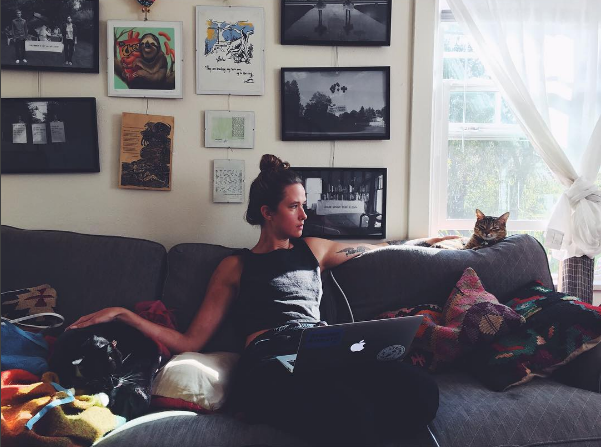
For the last month I’ve been a nomad — working a remote job, for a remote based company, in a very remote way. Living out of a suitcase, sleeping in hotels and working from coworking spaces. Flying between Berlin, Germany — Austin, Texas and Portland, Oregon — working to train two new teammates who have joined us on the support team at Basecamp. Since we are a dispersed company, we do our training a bit differently and fly our teams out to the same location to work together when someone is initially hired.
I can’t complain. I love that I get the opportunity to help onboard new employees and I jumped at the chance to be involved. I’m a traveler at heart and it’s something I’ve always loved, but while I know that to be true, this has been different than traveling for myself or traveling for vacation — this has been purely work related and is a different experience entirely.
I’ve learned a few things:
1) How to embrace differences and become a bit more flexible
Learning how to adapt and how to be flexible in new situations has been something I’ve dealt with a lot over the last few weeks and years. Living abroad in Germany for the last 6 years has prepared me to be a bit more flexible when it comes to how I process differences in culture, how I deal with the ways things are done in a new place and how I interact with the overall feeling of groundlessness that change can foster.
Instead of fighting against those feelings of otherness (being an outsider in a new place), feeling uneasy about not knowing everything about a place and an overall feeling of clashing with the differences that are around me — I embrace them. Embracing otherness and being an outsider is not easy or natural for me — I’d love to fit in easily and feel a sense of belonging — I think a lot of people can relate to that. But, I’ve learned that’s it’s okay not to know everything or all the answers. It’s okay to ask questions and it’s okay to learn from others.
This leads me to the second thing I’ve learned –
2) How to listen and ask questions to learn
Learning how to really listen and to ask questions has helped me a lot when it comes to adapting to a new environment. Listening to learn and to understand the people I’m interacting with in a new place has helped open my mind up to new perspectives. Instead of fighting those differences, being judgmental and, assuming I know everything I need to know about a person or a place without interacting with them — once I start to understand something a bit more by learning from the source directly, I soften to the differences around me.
3) Letting go of control
Working from a hotel room and traveling for work purposes has allowed me to practice letting go of control. Something I struggle with is my need to control situations and I am a chronic worrier. I worry about things I can’t control and how they will affect me and my comfort. Working from home allows me to control my work environment: what I wear, when I work, when I eat lunch, when I talk out loud, what music I listen to or don’t, the noise level around me and so on. It’s pretty ideal for me and I know I work best in an isolated, quiet environment. But when you are working at a coworking space or from a hotel with other humans, all that control goes out the window! I’ve had to adapt and think about others needs and wants and let go of that control I usually have working from my own comfort zone.
4) Recognizing the importance of knowing what I need
I’ve also recognized that it’s important for me to be aware of what I need and that knowing myself is crucial in order to navigate through different environmental changes. The first week I lived and worked nomadically with others, I was miserable. I was tired, dehydrated, burned out and exhausted. I was doing my job excellently, but I was entirely outwardly focused! I thought I was there for our new employees who I was helping to train — giving them my attention and focus, but I was not showing up for myself and it was debilitating.
In order to take care of others without resentment, guilt, exhaustion and all those other things that come along with helping others, I realized that I need to take care of myself first. I wrote a list of everything that I need in order to show up for myself. For me that includes: working out, drinking a lot of water, eating good food, getting some alone time and getting adequate sleep. In the second week of training, I focused on all those things — making sure to show up for myself. When I needed time alone, I was communicative about that to the people I was working with and used those small moments to their fullest — recharging. It made a dramatic difference in regards to how I handled working remotely with others and the quality of my work improved. I still was not in control of the situation (because working with others includes “others” who have agency over themselves), but I was in control of my behavior in a situation.
4) Recognizing the impermanence of the situation
I think the most important thing I learned is that things are not always the same — they change. This has been incredibly helpful in times when I would take a look at the 3 weeks of my unnatural hotel dwelling, coworking life and feel uneasy about my decision to go so far outside my comfort zone. I recognized that this way of life is impermanent — it has a beginning and an end. Knowing this has helped me to enjoy the moments I’ve had with my wonderful teammates while in the same place (something that does not happen often), without feeling stuck to the idea that this is not my ideal way to live.
I’m not perfect at this — there have been hard times. There have been many moments where I’ve just wanted to be on my couch in Berlin, cuddling my dog. Recognizing the impermanence of the situation does not shield me from those difficult moments or the loneliness that can come from being far from home. Instead, it allows me space to acknowledge the difficult parts of a situation and let them go — not getting too closely stuck to them, because I know things will change. This has also helped me cultivate a bit more resilience and learn how to deal and process through moments of isolation. I like the mantra of “it’s not okay, but it will be” — which involves acknowledging hard things, but knowing they are not forever.
The things I’ve learned over the last few weeks — living in a hotel and coworking have been incredibly valuable. My mind has opened up to how I can work when I’m not in control of an environment and how I can when I am. I’ve realized there’s more than one way to work that works for me if I’m willing to stretch my perspective a bit. I hope to keep stretching.
If you liked this post, please hit the ❤️ button below.

